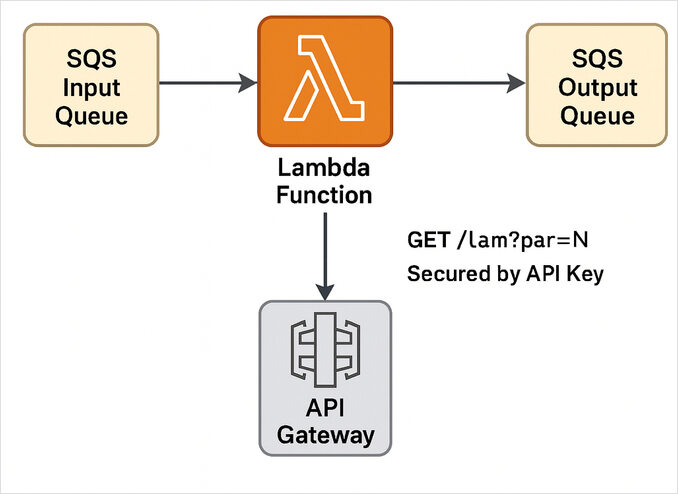Python과 Terraform을 사용하여 이중 모드 AWS Lambda 구축
단계별 예시
여기에서 SQS 메시지 처리기의 Python Lambda 예제 + API 키 보호 기능이 있는 REST API와 함께 Terraform 스크립트를 사용하여 서버리스 실행을 위해 배포할 수 있습니다.
AWS Lambda는 거의 모든 이벤트에 반응할 수 있는 가벼운 서버리스 함수를 작성할 수 있게 해줍니다 — SQS 메시지부터 HTTP 요청까지. 이 가이드에서는 단일 Python Lambda를 사용하여 두 가지 모드로 작동하는 것을 구축할 것입니다:
- SQS 모드: SQS 메시지로 트리거될 때, 예를 들어
{ "par": 10 }, 다른 대기열에{ "res": 11 }를 게시합니다. - HTTP 모드:
GET /lam?par=10에서 API Gateway를 통해 호출될 때, 클라이언트에게{ "res": 11 }을 반환합니다.
HTTP 엔드포인트는 간단한 하드코딩된 API 키 "testkey"를 사용하여 보호할 것입니다.
전체 설정은 Terraform을 사용하여 배포됩니다.
아키텍처 개요
우리가 구축하는 것을 시각화해 보겠습니다:

동일한 Lambda는 다음과 같이 반응합니다:
- SQS 이벤트, 이벤트 소스 매핑을 통해,
- API Gateway 요청, RESTful HTTP 통합을 통해.
단계 1: Python에서 Lambda 생성
SQS 이벤트와 HTTP API 호출 사이를 구분할 수 있는 매우 간단한 핸들러를 Python에서 생성해 보겠습니다.
파일: lambda_function.py
import json
import os
import boto3
sqs = boto3.client("sqs")
OUTPUT_QUEUE_URL = os.environ.get("OUTPUT_QUEUE_URL")
API_KEY = os.environ.get("API_KEY", "testkey") # 하드코딩된 기본값
def lambda_handler(event, context):
# 이벤트 유형 감지
if "Records" in event: # SQS 이벤트
return handle_sqs(event["Records"])
else: # HTTP 이벤트
return handle_http(event)
def handle_sqs(records):
for record in records:
body = json.loads(record["body"])
par = int(body["par"])
res = par + 1
message = json.dumps({"res": res})
sqs.send_message(QueueUrl=OUTPUT_QUEUE_URL, MessageBody=message)
return {"status": "processed", "count": len(records)}
def handle_http(event):
headers = {k.lower(): v for k, v in (event.get("headers") or {}).items()}
if headers.get("x-api-key") != API_KEY:
return {
"statusCode": 403,
"headers": {"Content-Type": "application/json"},
"body": json.dumps({"error": "Forbidden"})
}
params = event.get("queryStringParameters") or {}
if "par" not in params:
return {
"statusCode": 400,
"headers": {"Content-Type": "application/json"},
"body": json.dumps({"error": "Missing par"})
}
par = int(params["par"])
return {
"statusCode": 200,
"headers": {"Content-Type": "application/json"},
"body": json.dumps({"res": par + 1})
}
이 람다 함수에서 우리가 가지고 있는 것은 다음과 같습니다:
- SQS 메시지는 JSON으로 파싱됩니다.
- API Gateway에 의해 트리거될 때, 함수는 API 키와 쿼리 매개변수를 검증합니다.
- 출력 대기열 URL과 API 키는 환경 변수를 통해 전달됩니다.
단계 2: Terraform으로 배포
Terraform은 AWS 인프라 — Lambda, SQS 대기열, API Gateway 및 권한 —을 한 번에 선언적으로 설정할 수 있게 해줍니다.
프로젝트 구조:
project/
├── lambda/
│ └── lambda_function.py
└── infra/
└── main.tf
Terraform 구성 (infra/main.tf)
terraform {
required_providers {
aws = {
source = "hashicorp/aws"
version = "~> 5.0"
}
archive = {
source = "hashicorp/archive"
}
}
}
provider "aws" {
region = "us-east-1"
}
locals {
project = "lambda-sqs-api"
}
# Lambda 패키징
data "archive_file" "lambda_zip" {
type = "zip"
source_dir = "../lambda"
output_path = "lambda.zip"
}
# SQS 대기열
resource "aws_sqs_queue" "input" {
name = "${local.project}-input"
}
resource "aws_sqs_queue" "output" {
name = "${local.project}-output"
}
# Lambda를 위한 IAM 역할
data "aws_iam_policy_document" "assume_role" {
statement {
actions = ["sts:AssumeRole"]
principals {
type = "Service"
identifiers = ["lambda.amazonaws.com"]
}
}
}
resource "aws_iam_role" "lambda_role" {
name = "${local.project}-role"
assume_role_policy = data.aws_iam_policy_document.assume_role.json
}
resource "aws_iam_policy" "lambda_policy" {
name = "${local.project}-policy"
policy = jsonencode({
Version = "2012-10-17"
Statement = [
{
Effect = "Allow"
Action = [
"sqs:SendMessage",
"sqs:ReceiveMessage",
"sqs:DeleteMessage",
"sqs:GetQueueAttributes"
]
Resource = "*"
},
{
Effect = "Allow"
Action = [
"logs:CreateLogGroup",
"logs:CreateLogStream",
"logs:PutLogEvents"
]
Resource = "*"
}
]
})
}
resource "aws_iam_role_policy_attachment" "lambda_policy_attach" {
role = aws_iam_role.lambda_role.name
policy_arn = aws_iam_policy.lambda_policy.arn
}
# Lambda 함수
resource "aws_lambda_function" "func" {
filename = data.archive_file.lambda_zip.output_path
function_name = local.project
role = aws_iam_role.lambda_role.arn
handler = "lambda_function.lambda_handler"
runtime = "python3.12"
environment {
variables = {
OUTPUT_QUEUE_URL = aws_sqs_queue.output.id
API_KEY = "testkey"
}
}
}
# 이벤트 소스 매핑 (SQS → Lambda)
resource "aws_lambda_event_source_mapping" "sqs_trigger" {
event_source_arn = aws_sqs_queue.input.arn
function_name = aws_lambda_function.func.arn
batch_size = 1
enabled = true
}
# API Gateway
resource "aws_api_gateway_rest_api" "api" {
name = "${local.project}-api"
}
resource "aws_api_gateway_resource" "lam" {
rest_api_id = aws_api_gateway_rest_api.api.id
parent_id = aws_api_gateway_rest_api.api.root_resource_id
path_part = "lam"
}
resource "aws_api_gateway_method" "get_lam" {
rest_api_id = aws_api_gateway_rest_api.api.id
resource_id = aws_api_gateway_resource.lam.id
http_method = "GET"
authorization = "NONE"
api_key_required = true
}
resource "aws_api_gateway_integration" "lambda_integration" {
rest_api_id = aws_api_gateway_rest_api.api.id
resource_id = aws_api_gateway_resource.lam.id
http_method = aws_api_gateway_method.get_lam.http_method
integration_http_method = "POST"
type = "AWS_PROXY"
uri = aws_lambda_function.func.invoke_arn
}
resource "aws_lambda_permission" "api_gateway" {
statement_id = "AllowAPIGatewayInvoke"
action = "lambda:InvokeFunction"
function_name = aws_lambda_function.func.function_name
principal = "apigateway.amazonaws.com"
source_arn = "${aws_api_gateway_rest_api.api.execution_arn}/*/*"
}
# API 키 및 사용 계획
resource "aws_api_gateway_api_key" "key" {
name = "testkey"
value = "testkey"
enabled = true
}
resource "aws_api_gateway_usage_plan" "plan" {
name = "basic"
api_stages {
api_id = aws_api_gateway_rest_api.api.id
stage = aws_api_gateway_deployment.deploy.stage_name
}
}
resource "aws_api_gateway_usage_plan_key" "plan_key" {
key_id = aws_api_gateway_api_key.key.id
key_type = "API_KEY"
usage_plan_id = aws_api_gateway_usage_plan.plan.id
}
resource "aws_api_gateway_deployment" "deploy" {
depends_on = [aws_api_gateway_integration.lambda_integration]
rest_api_id = aws_api_gateway_rest_api.api.id
stage_name = "v1"
}
output "api_url" {
value = "${aws_api_gateway_deployment.deploy.invoke_url}/lam"
}
단계 3: 배포 및 테스트
- Terraform 초기화:
cd infra
terraform init
- 구성 적용:
terraform apply
- API Gateway 엔드포인트 테스트:
curl -H "x-api-key: testkey" "<API_URL>?par=10"
# 예상 결과: {"res": 11}
- SQS 테스트:
입력 대기열에 메시지 전송:
aws sqs send-message --queue-url <input-queue-url> --message-body '{"par": 5}'
그런 다음 출력 대기열 확인:
aws sqs receive-message --queue-url <output-queue-url>
# 예상 결과: {"res": 6}
단계 4: 정리
모든 리소스를 제거하려면:
terraform destroy
요약
[SQS 입력 대기열] ─▶ [Lambda 함수] ─▶ [SQS 출력 대기열]
▲
│
[API Gateway /lam?par=N]
│
API 키로 보호됨
당신은 이제 다중 트리거 Lambda를 구축했습니다:
- SQS 대기열에서 메시지를 소비하고 게시합니다.
- API Gateway를 통해 HTTP 요청에 응답합니다.
- 간단한 헤더 검사를 통해 API 키를 강제합니다.
- Terraform을 통해 완전히 관리되는 서버리스 인프라를 위해 배포됩니다.

이 패턴은 가벼운 메시지 변환기, 하이브리드 마이크로서비스, 또는 비동기 및 동기 AWS 시스템을 연결하는 데 모두 몇 줄의 Python과 Terraform만으로 사용할 수 있습니다.
더 고급의 Lambda 예제를 보고 싶다면, 이 게시물을 확인해 보세요: AWS SAM + AWS SQS + Python PowerTools를 사용한 Lambda 코딩

